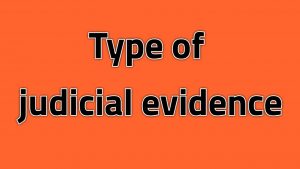The law of evidence is an important part of the legal system of every state. As a lawyer, law student or legal scholar, it is pivotal to know the different types of judicial evidence. This is because, knowing the different classifications of evidence will help you to know whether or not, a particular evidence will be admissible in court.
It will also help you to know the weight attached to any evidence brought before the court of law. For instance, a direct evidence apparently has more weight in the law of evidence than any evidence. The reason is because direct evidence is based on the personal knowledge of a person.
In light of the above, i will be discussing the various types of evidence that can be brought before the court of law. This is basically to educate lawyers all over the world on the types of judicial evidence and the circumstances on which they should be brought before the court. But before I move to the crux of this article, let’s quickly examine the various definitions of evidence.
Also read:
What is an Evidence?
The word “Evidence” may have several meaning depending on the context in which it is used. On the one hand, it may refer to testimony that had been given by a witness in court, or it may refer to legally admissible testimony. According to Cross and Tapper, the evidence of an act is that which tends to prove it. Something which may satisfy an inquirer of the facts existence.
Blacks Law Dictionary defines evidence as something, including testimony, documents and tangible objects that tends to prove or disprove the existence of an alleged facts. It may also be defined as, Any matter of Fact which is furnished to a legal tribunal, otherwise than by reasoning or a reference to what is noticed without proof, as the basis of interference in ascertaining some other matter of fact.

From the above definition of Evidence, it can be said that Evidence deals with facts in issue. Facts in issue, means relevant facts. These relevant facts are admissible in evidence.
Must read:
- Why lawyers are liars? Reasons why lawyers are called liars
- Why indirect rule failed in Eastern Nigeria: See reasons
Types of Evidence In Law
Below are the major types of judicial evidence:
- Direct evidence
- Circumstantial evidence
- Hearsay Evidence
- Primary and secondary evidence
- Real evidence
- Best Evidence
- Documentary Evidence
- Opinion evidence
There you have a list of the different types of judicial evidence that can be brought before the court. For a detailed explanation of these, i enjoin you to continue reading as I explain each of the type of evidence enumerated above.

Must read: Know your Fundamental human rights in the constitution of Nigeria
1. Direct evidence: Direct evidence is evidence that is based on personal knowledge or observation and that, if true, proves a fact without interference or presumption. Direct evidence is sometimes referred to as testimonial evidence. It is the testimony directly asserting the facts in issue. In this present context, direct evidence means the evidence of the fact in issue in a trial.
In a murder trial, the evidence of a witness who saw the accused person killing the deceased is direct evidence. Where direct evidence of an incident is not available, the law allows the court to infer from the proven facts the existence of other facts that may be logically inferred.
2. Circumstantial evidence: Circumstantial evidence is defined as evidence based on interference and not on personal knowledge or observation. Circumstantial evidence has also been defined as evidence of some collateral facts from which the existence or non-existence of some facts in question may be inferred as a probable consequence.
According to Aguada, Circumstantial evidence must alway be narrowly examined, if only because, this types of evidence, may be more easily fabricated to cast suspicion on innocent persons. In other to support a conviction based on Circumstantial evidence, the evidence must not only be cogent and compelling, but must also lead to the irresistible conclusion that is was the accused and no one else that committed the offense.
Must read:
3. Hearsay Evidence: The evidence act of Nigeria defines Hearsay Evidence as a statement, oral or written made otherwise than by a witness in proceeding or contained or recorded in a book, document or any record whatsoever, proof of which is not admissible under any provision of this act, which is tendered in evidence for the purpose of proving the truth of the matter stated in it.
Generally, Hearsay Evidence is inadmissible in court. For instance, “A” is not allowed to give evidence in court to the effect that “B” told him that he saw “X” stealing a Goat. According to Wigmore, the hearsay rule has been over enforced and abuse, the spoiled child of the family. That is has become a nuisance and obstruction to speedy and efficient trials.
4. Primary and secondary evidence: Primary evidence is often used in respect to documents. Primary evidence as it relates to documents is the document itself. That is, the original document. Section 86 of the Evidence act of Nigeria provides that, primary evidence means the document itself produced for the inspection of the court.
On the other hand, secondary evidence includes copies made from the original evidence. A secondary evidence is inferior to primary evidence and becomes admissible when the primary or best evidence is lost or inaccessible.
Also read:
- Importance of local government in a state/country
- Solutions to the problems of local government in Nigeria
5. Real evidence: Real evidence is anything other than testimony, admissible hearsay or a document, the content of which are offered as evidence of a fact as a trial, which is examined by the court as a means of proof of such fact.
From the above definition, one can say that real evidence is not a testimony in court; real evidence is not an admissible hearsay and real evidence is not a document, the content of which at offered as evidence of fact at a trial, which is examined by the court as a means of proof of such fact. This definition is provided for in section 258 of the Evidence act of Nigeria.
Real evidence means physical evidence, such as a book presented in the court in an action for trespass to goods or a cloth or a knife wound. It is the production in the court of the material thing.
6. Best Evidence: This refers to evidence of the highest quality available as measured by the nature of the case rather than the thing being offered as evidence. It is also termed primary evidence or original evidence. Primary evidence is best evidence. Best evidence is usually applied to writings and recordings. If the original is available, it must be offered rather than a copy.
In the case of Womiloju v Kiki [2009] 16 NWLR, pt 1166, p. 144, it was held that, the best evidence of the content of a document is the production of the document itself.
Also read:
- Donoghue v Stevenson: Facts, Issues and decision of the court
- Mojekwu v Mojekwu: Facts, Issues and Decision of the court
7. Documentary Evidence: According to the Black’s Law Dictionary, Documentary Evidence includes books, maps, plans, drawings, photographs and also includes any matter expressed or described upon any substance by means of letters, figures or marks or by more than one of these means, intended to be used or which may be used for the purpose of recording that matter.
In short, Documentary Evidence is any statement made in a document which is offered to the court in proof of any fact in issue. Central to the analysis of documentary evidence are the issue of admissibility, custody and relevancy of such documentary evidences.
8. Opinion evidence: In the law of evidence, opinion means any interference from observed facts and the law on the subject derives from the general rule that witness must speak only to that which was directly observed by them. The general rule behind opinion evidence is that a withness is not allowed to give his opinion as to existence or non-existence of a fact in issue or relevant fact. Such evidence of opinion is regarded as irrelevant and therefore inadmissible in court.
The reason for the the inadmissibility of opinion evidence is based on the assumption that it is possible to draw a sharp distinction between interference and the fact on which they are based. The duty of the witness is to state the facts as he has observed, while the duty of the court is to draw the necessary interference from the facts stated by the witness.
Also read:
- Richest lawyers in in Nigeria: 11 wealthiest Lawyers in Nigeria in 2024
- Pillars of democracy: See the pillars of democracy state
Yeah! That is all on the types of judicial evidence. In summary, I have enumerated and explained 8 (eight) types of legal evidence. In my opinion, it is supposed that every lawyer and law student know this topic. In fact, it is one of the basics in the law of evidence. Hope this was helpful? If you still have any contribution to make on this topic, kindly send it using the comment section below this article. I will be glad to hear from you.

Edeh Samuel Chukwuemeka, ACMC, is a lawyer and a certified mediator/conciliator in Nigeria. He is also a developer with knowledge in various programming languages. Samuel is determined to leverage his skills in technology, SEO, and legal practice to revolutionize the legal profession worldwide by creating web and mobile applications that simplify legal research. Sam is also passionate about educating and providing valuable information to people.
Love your blog, do you have a YouTube Channel as well?
This is great article! Thank you 🙂